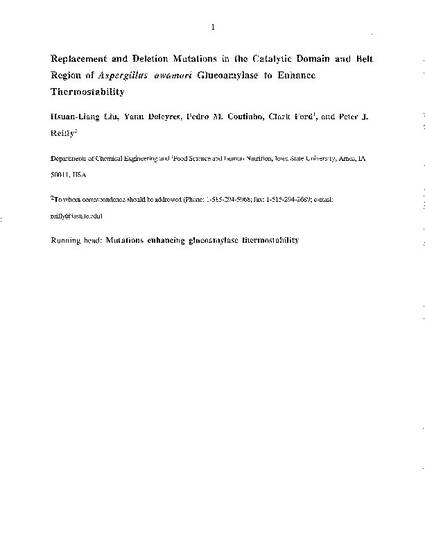
Three single-residue mutations, Asp71→Asn, Gln409→Pro and Gly447→Ser, two long-to-short loop replacement mutations, Gly23-Ala24-Asp25-Gly26-Ala27-Trp28-Val29-Ser30→Asn-Pro-Pro (23–30 replacement) and Asp297-Ser298-Glu299-Ala300-Val301→Ala-Gly-Ala (297–301 replacement) and one deletion mutation removing Glu439, Thr440 and Ser441 (Δ439–441), all based on amino acid sequence alignments, were made to improve Aspergillus awamori glucoamylase thermostability. The first and second single-residue mutations were designed to introduce a potential N-glycosylation site and to restrict backbone bond rotation, respectively, and therefore to decrease entropy during protein unfolding. The third single-residue mutation was made to decrease flexibility and increase O-glycosylation in the already highly O-glycosylated belt region that extends around the globular catalytic domain. The 23–30 replacement mutation was designed to eliminate a very thermolabile extended loop on the catalytic domain surface and to bring the remainder of this region closer to the rest of the catalytic domain, therefore preventing it from unfolding. The 297–301 replacement mutant GA was made to understand the function of the random coil region between α-helices 9 and 10. Δ439–441 was constructed to decrease belt flexibility. All six mutations increased glucoamylase thermostability without significantly changing enzyme kinetic properties, with the 23–30 replacement mutation increasing the activation free energy for thermoinactivation by about 4 kJ/mol, which leads to a 4°C increase in operating temperature at constant thermostability.
Available at: http://works.bepress.com/peter_reilly/24/

This is a post-print of an article from Protein Engineering, 13, no. 9 (2000): 655–659, doi: 10.1093/protein/13.9.655.